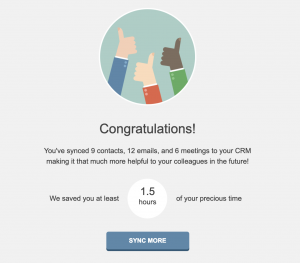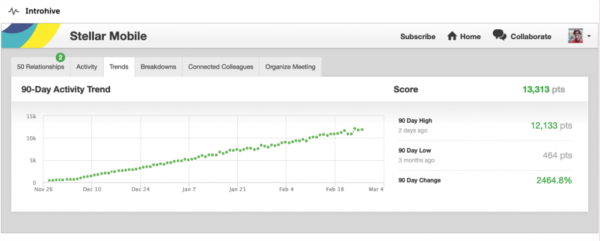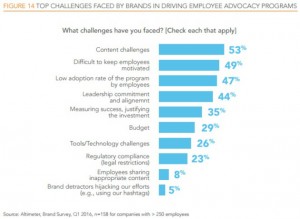— September 19, 2019

A referral is the kick start to the buying process for a staggering 84 percent of all buyers. That means client satisfaction should be a top priority if you want to grow top-line revenue. Not only do happy clients make glowing recommendations; they also stick around to add revenue year-over-year.
But do you have what it takes to keep, grow and build these lasting relationships? If you don’t have a 360-degree view of your total network (your organization, prospects, clients, etc.), the answer is likely no.
But good news: that holistic view is within reach. Say hello to your new best friend, relationship intelligence automation (RIA). Read on to get better acquainted and find out why it’s destined to be a tool you can’t do without.
Section Guide:
- What does relationship intelligence automation do?
- How does relationship intelligence automation work?
- What relationship intelligence solution is right for me?
- TL;DR / relationship intelligence automation in a nutshell
What does relationship intelligence automation do?
It reveals opportunities to sell more effectively
Sales and business development professionals crave strategic guidance and information that can save time, help them advise prospects and clients, close deals faster and generate more revenue.
Thanks to customer relationship management (CRM) tools, a lot of that information is already stored within a company’s purview. But almost no one has the time or resources to manually connect it all together. That’s where RIA comes in.
RIA automatically collects, stores and analyzes client data from multiple sources, like social media, email signatures and email interactions. Then it serves up CRM users with a relationship map and workable relationship insights—like who knows who and how well. That’s valuable information when it comes to identifying who to reach out to and when, and helping you accelerate sales and strengthen relationships at the same time.
It fosters CRM user adoption, clean and complete data

Instantly see how much time Introhive’s Contact and Activity sync saves you.
CRM systems have the power to harness valuable intelligence—but that’s only true if their data is complete and correct. That’s a problem if you cannot get engagement from employees to do the data entry.
Rest assured, however, if your organization struggles with getting users to enter account and contact information into the CRM, you’re not alone. In fact, 45 percent of organizations don’t use a CRM tool for lead and customer data at all. And 22 percent of salespeople don’t even know what CRM is. Even the top 10 percent of sales organizations struggle with CRM adoption.
But with RIA, the data collection is automatic. Passing mundane data entry tasks from your team to smart automation technology not only ensures your CRM data is complete; it frees up your people to do what they do best—build relationships and sell.
It keeps tabs on relationships
Acquiring new clients is an important, yet often an expensive, endeavor. Before you put all your eggs in that basket, you might consider targeting existing client relationships where there is room to grow. It’s not only more cost-effective but also helps build stronger relationships. RIA relationship mapping and insights can help you here, too.
Say you have strong connections with senior people in a client’s business, but not so much with their junior members. If you were unaware of this gap, it could eventually affect your long-term potential as those junior contacts rise through the ranks to become decision-makers and purchasing influencers. But using RIA to map your relationships within the company means you’ll spot those gaps immediately and can get out in front for fostering relationships early on in the process.
RIA can also warn you if it detects potentially at-risk client relationships—such as noticing if an existing client hasn’t had an interaction with your client success team or the Partner with the strongest relationship within your company in over 60 days. With fair warning from RIA, your firm can take proactive steps to stay on top of proactive client communication to ensure the highest client retention and satisfaction.
How does relationship intelligence automation work?
It collects data from multiple sources
From transactional data to customer service inquiries to social media profiles and other online activities, RIA passively collects any information it can from inside and outside your business. This gives you a more complete picture of who your customers and prospects are.
It serves up easy-to-understand reports
Relationship intelligence automation solutions don’t just collect and analyze data, they also turn it into actionable insights. Users get access to clear, relevant account and contact analytics in right within a firm’s CRM or via mobile devices.
RIA tools can also automatically deliver tailored, pre-meeting insight reports right to your inbox. Among other valuable pieces of information, these reports provide background on everyone in the meeting, who knows who and how well, among other valuable pieces of information. That means you can walk into a business development meeting fully prepped after a quick read, versus hours of research.

What relationship intelligence solution is right for me?
Now that you’re well-versed in all things RIA, you understand that to remain competitive, RIA is a must have for your firm. But how do you know which solution is the best fit for your organization? Just follow these three simple steps.
1: Evaluate your CRM adoption
Monitor your CRM reporting to see who logs in and who doesn’t. If possible, review how long users stay signed in. This will help establish your current CRM adoption benchmarks.
Next, anonymously survey your CRM users to find out what keeps them from using the CRM, whether its lack of time, lack of training or a perceived lack of value.
2: Set objectives
Before you look for a relationship intelligence solution, it’s important to set goals and objectives to make sure you get the most value out of the tool. Ask yourself questions like:
- Which metrics are the most valuable to sales and business development?
- What do I want to improve? Reduce admin time, improve adoption, see more relationship data?
- Who is the right person to be the executive sponsor to ensure program success?
- How do I want my team to access RIA? Who should see what?
These objectives will serve as a guide for finding the right RIA vendor.
3: Research providers
The right vendor will help you reach your RIA and business development goals. When researching RIA solutions, the first priority should be to understand their integration capabilities. Then compare your objectives against their offerings to narrow down your options.
TL/DR / RIA in a nutshell
RIA gets more mileage out of your CRM by automatically entering critical prospect and customer data into the system. The result? Decreased manual data entry, increased CRM adoption, higher-quality CRM data, enhanced productivity and the effective insights organizations need to make informed decisions.
If you want a leg up on meeting demanding customer expectations, identifying interaction opportunities, building stronger relationships, and driving more business, RIA might be a good fit for your organization.
Business & Finance Articles on Business 2 Community
(35)





